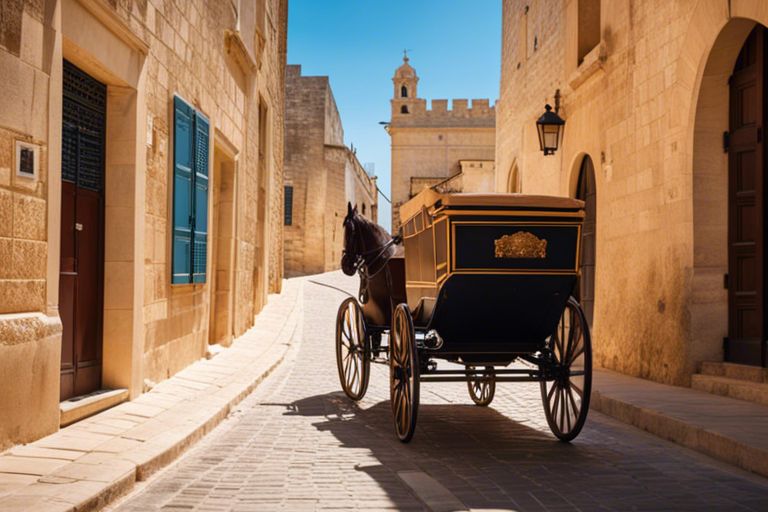Discover Malta’s Ancient Capital – Mdina

This enchanting walled city holds within its ancient walls a wealth of history and charm waiting to be explored. Mdina, located in the heart of Malta, is a destination unlike any other. Stepping into Mdina is like stepping back in time, with its narrow winding streets and stunning architecture that dates back over 4,000 years. As you wander through the labyrinthine streets, you will encounter hidden gems around every corner, from quaint cafes to historic landmarks that speak to the city’s storied past.
However, exploring Mdina can be tricky for first-time visitors due to its maze-like layout. But fear not, this comprehensive guide will lead you through the must-see attractions, best restaurants, and insider tips to make the most of your visit. From the imposing Mdina Gate to the awe-inspiring St. Paul’s Cathedral, each corner of Mdina is steeped in history and culture just waiting to be discovered.
Whether you are a history buff, a foodie, or simply looking to immerse yourself in the beauty of Malta, Mdina has something for everyone. So, lace up your walking shoes and get ready to initiate on an unforgettable journey through Malta’s ancient capital. Let this guide be your companion as you uncover the timeless allure of Mdina and create memories to last a lifetime.
The History of Mdina
Prehistoric Beginnings to the Medieval Period
While the history of Mdina traces back to prehistoric times, it truly flourished during the Medieval period. An ancient city, Mdina was founded by the Phoenicians around the 8th century BC. Over the centuries, it was inhabited by various civilizations, including the Romans and Arabs. The city reached its peak during the Medieval period when it served as the capital of Malta.
An important trading hub, Mdina’s strategic location on a hilltop made it an ideal stronghold for rulers to oversee the island. The city’s architecture, a mix of medieval and baroque styles, reflects its rich history. The well-preserved walls and narrow streets transport visitors back in time, offering a glimpse into Malta’s medieval past.
Strong fortifications surrounded Mdina during the Medieval period, protecting it from invasions. It was a center of culture, religion, and governance, with notable palaces and cathedrals dotting its landscape. The city’s prominence continued until the arrival of the Knights of St. John in the 16th century.
The Role of Mdina in the Knights of St. John Era
Beginnings as a small military order in Jerusalem during the 11th century, the Knights of St. John grew into a formidable force by the time they arrived in Malta. It was during this era that Mdina’s role transformed significantly. The Knights recognized the city’s strategic importance and made it their administrative center, alongside strengthening its fortifications.
It was a time of grandeur and prosperity for Mdina, as the Knights invested in lavish palaces and churches to showcase their power. The city became a symbol of the Order’s influence in Malta. The Knights of St. John era marked a significant chapter in Mdina’s history, shaping its identity for centuries to come.
In 1798, the French invasion marked the end of the Knights’ rule in Malta, paving the way for British dominance. Mdina transitioned through these changes, adapting to new rulers and influences. The city’s fortifications, though no longer as vital for defense, stood as a testament to its rich history and strategic significance.
Mdina's Transition Through the French and British Rule
While the French rule brought about significant changes in Malta, including the confiscation of church property and the restructuring of society, Mdina managed to retain its historic charm. The British rule that followed brought stability and modernization to the island, leading to infrastructural developments while preserving Mdina’s cultural heritage.
A symbol of Malta’s resilience, Mdina’s transition through different periods of rule reflects its adaptability and enduring spirit. Today, the city stands as a living museum, showcasing the layers of history that have shaped it over millennia. Exploring Mdina offers a journey through time, from its ancient origins to its colonial past, providing visitors with a glimpse into Malta’s rich heritage.
Present-Day Mdina: Preserving the Past
There’s a concerted effort in present-day Mdina to preserve its historical legacy while catering to modern needs. The city’s streets are lined with museums, galleries, and quaint cafes, offering visitors a blend of cultural experiences. The preservation of Mdina’s architectural heritage, including its palaces, cathedrals, and city walls, highlights the city’s commitment to honoring its past.
Understanding the Types of Attractions in Mdina
Any visitor to Mdina will be astounded by the diverse range of attractions the ancient capital has to offer. From historical landmarks and monuments to religious sites steeped in centuries of faith, Mdina is a treasure trove waiting to be explored. Additionally, the city boasts a variety of museums and cultural spaces that offer insights into its rich history and vibrant culture. Not to mention, Mdina is home to picturesque recreational spots and gardens that provide a tranquil escape from the hustle and bustle of modern life.
Historical Landmarks and Monuments
You will be transported back in time as you explore the historical landmarks and monuments that dot the landscape of Mdina. From the imposing Mdina Gate to the majestic St. Paul’s Cathedral, each site tells a story of the city’s rich past. The ancient city walls and the Palazzo Falson Historic House Museum are also must-visit attractions for history enthusiasts.
Assume that every corner you turn in Mdina will reveal a new piece of history waiting to be discovered. The architecture and craftsmanship of these landmarks are truly awe-inspiring, providing a glimpse into the grandeur of Mdina’s heyday.
Religious Sites with Centuries of Faith
While exploring Mdina, you cannot miss the religious sites that have stood the test of time and witnessed centuries of faith. The Carmelite Priory and the Mdina Cathedral Museum are prime examples of the city’s religious heritage. The intricate artwork and religious artifacts found in these sites are a testament to the devotion and craftsmanship of generations past.
With spirituality woven into the fabric of Mdina’s history, these religious sites offer visitors a unique opportunity to examine into the city’s spiritual roots and connect with its enduring legacy.
Museums and Cultural Spaces
Any art and culture enthusiast will find a wealth of knowledge and inspiration in Mdina’s museums and cultural spaces. The Mdina Experience and the National Museum of Natural History are perfect places to immerse yourself in the city’s rich cultural tapestry. The Mdina Glass and Palazzo de Piro are also not to be missed for a glimpse into the city’s artistic heritage.
Another fascinating aspect of Mdina’s cultural spaces is the opportunity to witness traditional crafts being practiced firsthand. From glassblowing to pottery making, these spaces provide a window into Malta’s artisanal traditions, keeping them alive for future generations.
Recreational Spots and Gardens
Gardens within Mdina, such as the Palazzo Falson Historic House courtyard and the Bastion Square Gardens, offer a peaceful respite from the bustling city streets. These serene spots provide the perfect setting for a leisurely stroll or a moment of quiet contemplation amidst the city’s ancient walls and architectural wonders.
To experience Mdina fully, make sure to explore these recreational spots and gardens, where nature and history converge to create a truly enchanting atmosphere.
Navigating Mdina: A Step-by-Step Guide
Despite its medieval charm and narrow winding streets, navigating through Mdina is relatively straightforward once you have a plan in place. Below is a step-by-step guide to help you make the most of your visit to Malta’s ancient capital.
| Planning Your Visit: Factors to Consider | Arriving in Mdina: Tips on Transportation |
Planning Your Visit: Factors to Consider
Perceiving these factors will help you plan a more enjoyable visit to Mdina. |
Arriving in Mdina: Tips on Transportation
Assume that transportation options may be limited within Mdina itself. |
Navigating through Mdina on foot is the best way to soak in the historic ambiance of the city. The quaint streets, charming alleyways, and medieval architecture are best explored at a leisurely pace. There’s a sense of timelessness that engulfs you as you wander through the ancient streets, making each corner a discovery waiting to unfold.
Exploring on Foot: A Walking Tour Blueprint
There’s a unique charm in getting lost in Mdina’s labyrinth of streets and stumbling upon hidden gems like St. Paul’s Cathedral, the Mdina Dungeons, and the Palazzo Falson Historic House Museum. Blueprint your walk to include all the must-see attractions while leaving room for spontaneous discoveries.
Accessibility and facilities within Mdina are relatively good, with ramps and designated pathways for visitors with mobility challenges. Tour the city with ease, but keep in mind that some areas may be inaccessible to wheelchairs due to the ancient architecture and narrow pathways. Exploring the city’s ancient wonders is a rewarding experience for all visitors, just plan accordingly to ensure a smooth and enjoyable visit.
Accessibility and Facilities: Ensuring a Smooth Experience
Tour with peace of mind knowing that restroom facilities and food options are available within Mdina’s walls. Exploring the ancient capital of Malta is a delightful experience, made even better with facilities catering to the needs of all visitors.
Experiencing Mdina’s Gastronomic Offerings
Many travelers visiting Mdina are drawn to its rich culinary heritage, which offers a blend of traditional Maltese flavors and contemporary dining experiences. The ancient city is a culinary paradise, with a myriad of options to indulge in the local cuisine and savor the unique flavors of Malta. Whether you are a food enthusiast or simply looking to enjoy a delicious meal, Mdina has something for everyone.
Traditional Maltese Cuisine: Types and Tips
Maltese cuisine is a reflection of the island’s history and diverse influences, including Italian, Arabic, Spanish, and French. Some typical dishes you must try include Fenek (rabbit stew), Kapunata (Maltese ratatouille), and Pastizzi (flaky pastries filled with ricotta or mushy peas). When dining in Mdina, be sure to pair your meal with local wines such as Gellewza and Ghirgentina for an authentic experience. Remember to pace yourself and enjoy the flavors slowly to fully appreciate the complexity of Maltese cuisine.
| Fenek (rabbit stew) | Kapunata (Maltese ratatouille) |
| Pastizzi (flaky pastries) | Gellewza and Ghirgentina (local wines) |
Though Maltese cuisine has a strong emphasis on meat and seafood dishes, there are also plenty of options for vegetarians and vegans. Exploring the local markets and cafes will give you a better understanding of the ingredients and flavors that define Maltese cooking. Whether you are dining in a traditional Maltese restaurant or a cozy cafe, you are sure to be delighted by the culinary delights that Mdina has to offer.
Contemporary Dining: Balancing Tradition and Modernity
Types of eateries in Mdina offer a modern twist on traditional Maltese dishes, combining classic flavors with innovative techniques. Contemporary restaurants in Mdina provide a unique dining experience where you can savor innovative dishes while still appreciating the roots of Maltese cuisine. The chefs in these establishments often experiment with local ingredients and international culinary trends to create a fusion of flavors that appeal to a diverse palate. To fully appreciate the evolution of Maltese cuisine, a visit to one of Mdina’s contemporary dining establishments is a must. These restaurants showcase the creative talents of local chefs who are passionate about preserving the heritage of Maltese food while embracing modern culinary practices. Whether you opt for a Michelin-starred restaurant or a cozy bistro, you are sure to be impressed by the inventive dishes and impeccable service.
Cafes and Tea Gardens: Savoring Local Flavors and Views
With stunning views of the surrounding countryside and the Mediterranean Sea, Mdina’s cafes and tea gardens offer the perfect setting to relax and enjoy a leisurely meal. These charming establishments serve a variety of local delicacies such as Imqaret (date pastries) and Helwa tat-Tork (sweet sesame bars) paired with aromatic Maltese coffee or refreshing herbal teas. Whether you are craving a light snack or a hearty meal, the cafes and tea gardens in Mdina cater to every taste. Mdina’s cafes and tea gardens are not just places to eat; they are also hubs of social activity where locals and tourists come together to enjoy good food and pleasant company. These establishments provide a unique opportunity to immerse yourself in the local culture and witness the traditional way of life in Mdina. Whether you choose to dine indoors or al fresco, the experience of savoring local flavors amidst breathtaking views is one you will not soon forget.
Shopping in Mdina: A Guide to Finding Unique Treasures
After immersing yourself in the rich history and unique atmosphere of Mdina, it’s time to explore the city’s shopping scene. Mdina offers a plethora of opportunities to find one-of-a-kind treasures that you won’t come across anywhere else. From artisan crafts and souvenirs to local markets and boutiques, there’s something for every shopper looking to take home a piece of Malta.
Artisan Crafts and Souvenirs: Types and Choosing Tips
For those interested in artisan crafts and unique souvenirs, Mdina is a treasure trove. From intricate glassware to handmade lace, there is no shortage of handcrafted items to choose from. When dicking out your purchases, look for pieces that showcase the traditional Maltese craftsmanship and heritage. Opt for items that are made locally and support the island’s artisans. Remember to ask about the story behind the piece you are considering purchasing – this adds a special meaning to your keepsake. Though bargaining is not common practice in most shops, it’s always worth asking for a discount on larger purchases.
| Pros | Cons |
| Opportunity to purchase unique, handcrafted items | Bargaining may not always be accepted |
| Supporting local artisans and their traditional crafts | Quality vs. price may vary |
| Chance to own a piece of Maltese heritage | Some items may be pricier due to their artisanal nature |
Local Markets and Boutiques: Shopping Hubs for Authentic Finds
Shopping in Mdina extends beyond individual artisan shops into local markets and boutiques. These bustling hubs offer a wide range of authentic Maltese products, from handwoven textiles to delicious local delicacies. Whether you’re looking for a unique piece of jewelry or a traditional Maltese snack to enjoy later, these markets provide an opportunity to experience the local culture through its goods.
Treasures found in these markets and boutiques often come directly from local craftsmen and producers, ensuring their authenticity and quality. The vibrant atmosphere and the hustle and bustle of shoppers and vendors create an engaging shopping experience that is truly Maltese in spirit.
Negotiating Prices: Pros and Cons
Tips for negotiating prices: For savvy shoppers looking to get the best deals, negotiating prices can be a useful skill. In Mdina, some vendors may be open to a little haggling, especially in markets or with larger purchases. However, it’s vital to approach this practice with respect and politeness. For instance, always start by asking for a lower price rather than demanding a discount.
| Pros | Cons |
| Potential to secure a better deal | Risk of offending the seller |
| Opportunity to get more value for your money | Not all vendors are open to negotiation |
| Can be a cultural experience | Time-consuming process |
Customs and Duty: What You Need to Know for Export
Know for export: When purchasing items in Mdina for export, it’s important to be aware of any customs and duty regulations that may apply to your home country. Certain items, especially those made from protected materials or of high value, may be subject to specific regulations. It’s advisable to inquire with the vendor or research beforehand about any restrictions or requirements to ensure a smooth transaction.
What you bring back from Mdina should not only be unique and valuable but also meet the necessary requirements for export. By staying informed and understanding the customs and duty regulations, you can enjoy your souvenirs without any unexpected surprises when returning home.
Accommodation Options in Mdina
Hotels and Guesthouses: Factors to Decide Where to Stay
All visitors to Mdina are spoilt for choice when it comes to accommodation options. Hotels and guesthouses are popular choices for those looking for a comfortable and convenient stay. When deciding where to stay, consider factors such as location, amenities, price, and reviews to ensure a pleasant experience during your visit. The availability of on-site dining options and parking facilities can also be crucial depending on your preferences. Furthermore, proximity to tourist attractions and ease of transportation should be taken into account.
- Location
- Amenities
- Price
- Reviews
- Dining options
- Parking facilities
The choice of hotel or guesthouse in Mdina can significantly impact your overall experience of the ancient city. It’s crucial to consider all these factors before making a decision.
Boutique Experiences: Pros and Cons of Specialized Accommodations
For travelers seeking a unique and personalized stay, boutique accommodations offer a distinct experience. These specialized lodgings often feature unique decor, personalized services, and attention to detail that set them apart from traditional hotels. However, while boutique experiences can be charming, they may come with higher costs and limited amenities compared to larger establishments.
| Pros | Cons |
| Unique decor | Higher costs |
| Personalized services | Limited amenities |
| Attention to detail |
While boutique accommodations offer a one-of-a-kind experience, it’s crucial to weigh the pros and cons before booking to ensure it aligns with your travel preferences.
Vacation Rentals: Tips for Selecting Your Home Away From Home
Specialized vacation rentals provide an alternative accommodation option in Mdina, offering visitors a chance to stay in unique properties with a more homely feel. When deciding on a vacation rental, consider factors such as location, property type, reviews, and host communication to ensure a seamless stay. Knowing the cancellation policy and amenities provided can also help in making an informed decision.
- Location
- Property type
- Reviews
- Host communication
- Cancellation policy
- Amenities
Specialized vacation rentals offer a personalized lodging experience, ideal for travelers looking for a more unique stay in Mdina. Consider these factors before finalizing your booking for a memorable vacation.
Budget Stays: Balancing Cost and Comfort
Cons are crucial when considering budget stays in Mdina. While cost-effective options can help you save on accommodation expenses, they may come with sacrifices in terms of amenities and convenience. However, with careful research and planning, budget stays can still offer a comfortable and enjoyable stay without breaking the bank.
Rentals:
When renting a vacation property directly from an owner, it’s important to ensure the legality of the arrangement and the safety of the property. Always verify the authenticity of listing platforms and owners, and consider purchasing travel insurance to protect your stay.
Seasonal Considerations for Visiting Mdina
Weather Patterns and What to Expect Each Season
What you can expect in terms of weather when visiting Mdina greatly depends on the season. Malta enjoys a Mediterranean climate with hot, dry summers and mild, wet winters. During the summer months from June to August, temperatures can soar up to 30°C (86°F), making exploring Mdina’s ancient streets quite challenging under the scorching sun. In contrast, winter, from December to February, sees milder temperatures averaging around 15°C (59°F) but with the occasional heavy rainfall.
Spring (March to May) and autumn (September to November) are considered the best times to visit Mdina as the weather is pleasant, with temperatures ranging from 18°C to 25°C (64°F to 77°F). These seasons offer comfortable conditions for sightseeing and exploring the historic city without the extreme heat or cold affecting your visit.
Festivals and Events: Timing Your Trip Accordingly
Seasonal events and festivals play a significant role in planning your visit to Mdina. The Maltese celebrate various cultural and religious festivities throughout the year, with many taking place in Mdina. The most renowned event is the Mdina Medieval Festival held in late April, attracting visitors with reenactments, market stalls, and cultural performances. Other notable festivals include the Mdina Grand Prix in October, featuring classic cars racing through the ancient streets, and the Christmas Village in December, offering a festive atmosphere with lights, decorations, and traditional Maltese treats.
These events not only add vibrancy and excitement to your visit but also provide insight into Malta’s rich history and traditions. Planning your trip around these festivals can enhance your overall experience and offer a unique perspective on Mdina’s ancient capital.
A visit to Mdina during these events provides an opportunity to immerse yourself in the local culture and witness the city coming alive with music, dance, and traditional performances. These experiences offer a deeper connection to the Maltese heritage and create lasting memories of your time spent in the ancient capital.
Off-Peak Advantages: Pros and Cons of Visiting During Low Season
To make an informed decision about when to visit Mdina, it’s important to consider the pros and cons of the low season. During the off-peak months from November to March, Mdina sees fewer crowds, allowing for a more intimate and tranquil exploration of the city. The cooler temperatures also make walking around the historic streets more comfortable without the scorching sun of summer.
| Advantages | Disadvantages |
| Less crowded attractions | Limited availability of tours and activities |
| Lower accommodation prices | Potential closures of restaurants and shops |
| Opportunity for peaceful exploration | Less vibrant atmosphere due to fewer visitors |
Despite these drawbacks, visiting Mdina during the low season can offer a unique experience for travelers seeking a more serene and authentic encounter with the historic city.
Peak Season Tips: Handling the Crowds and Maximizing Your Experience
For those planning a visit to Mdina during the peak season from May to September, it’s crucial to prepare for larger crowds and higher temperatures. To make the most of your trip, consider arriving early in the morning or later in the afternoon to avoid the busiest times. Exploring Mdina’s narrow streets and attractions during off-peak hours can help you beat the crowds and enjoy a more leisurely experience.
- Crowds: Visit popular sites early or late in the day.
- Weather: Stay hydrated and wear sunscreen to protect against the sun.
- Attractions: Prioritize must-see landmarks and plan your route accordingly.
After spending a day exploring Mdina, take some time to relax and unwind at one of the charming cafes or restaurants within the ancient city walls. Enjoying a local dish or a refreshing drink while overlooking the picturesque views can be the perfect way to end your day in Mdina.
Mdina offers a fascinating glimpse into Malta’s history and culture, with its ancient architecture, winding streets, and rich traditions. Whether you choose to visit during the lively festivals, serene low season, or bustling peak season, each time of year provides a unique perspective on this ancient capital. Plan your trip accordingly to make the most of your visit to Mdina and create unforgettable memories in this timeless city.
Safety and Etiquette in Mdina
Staying Safe: Tips and Precautions
Unlike bustling cities, Mdina’s streets are quieter and often less crowded, making it a relatively safe destination. However, it is always important to stay vigilant and mindful of your surroundings, especially when exploring narrow alleyways or less illuminated areas. Keep your belongings secure and be cautious of pickpockets in tourist-heavy areas. Avoid flashing valuables and consider using a money belt to keep your cash and important documents safe.
When walking around Mdina, be aware of uneven cobblestone streets and steps that may present tripping hazards. Wear comfortable shoes with good grip to navigate the historic city’s terrain safely. Additionally, be mindful of traffic when crossing roads, as some areas may not have designated pedestrian crossings. Obey traffic rules and use designated walkways where available to ensure your safety.
Perceiving Mdina as a place with a low crime rate, it is necessary to still practice common sense and follow basic safety precautions to have a pleasant and incident-free visit. By staying aware of your surroundings and taking simple steps to protect yourself and your belongings, you can enjoy exploring the ancient capital of Malta with peace of mind.
Cultural Sensitivity and Respectful Behavior
While visiting Mdina, respect for its cultural heritage and traditions is crucial to ensure a positive experience for both visitors and residents. Avoid loud noises and disruptive behavior that may disturb the tranquil atmosphere of the city. Dress modestly when visiting religious sites, such as churches or cathedrals, out of respect for the local customs and beliefs.
Behavior that is considered disrespectful or offensive in the local culture should be avoided. Refrain from public displays of affection in conservative areas and follow any guidelines or restrictions set by historical sites or attractions. By showing consideration and understanding towards the local customs, you can contribute to a harmonious atmosphere during your time in Mdina.
While exploring the city, take the time to learn about Maltese history and customs to gain a deeper appreciation for the destination. Embrace the opportunity to engage with the local community respectfully and be open to enriching cultural exchanges that can enhance your travel experience in Mdina.
Keeping Mdina Clean: Environmental Awareness
There’s a collective responsibility to maintain the cleanliness and beauty of Mdina for locals and visitors alike. Dispose of your waste in designated bins and avoid littering in public spaces. Respect the environment by refraining from damaging historical sites or landmarks, and preserve the integrity of the city’s architecture by not defacing or vandalizing any structures.
Precautions such as reducing plastic waste by carrying a reusable water bottle and bag can contribute to the sustainability efforts in Mdina. Show appreciation for the historic surroundings by being mindful of your impact on the environment and participate in initiatives that promote eco-friendly practices within the city.
By maintaining a clean and sustainable environment in Mdina, we can ensure that future generations can continue to enjoy the rich history and cultural significance of this ancient capital. Every small effort towards environmental awareness plays a vital role in preserving the beauty and integrity of the city for years to come.
Photography and Privacy: Guidelines and Recommendations
While capturing memories through photography is a common practice, it is important to respect the privacy of locals and other visitors in Mdina. Avoid taking photos of individuals without their consent, especially in sensitive or private settings. Be mindful of cultural sensitivities and ask permission before photographing religious ceremonies or personal interactions.
Avoid using drones for aerial photography in Mdina, as it may disrupt the tranquility of the city and infringe on the privacy of residents. Follow any guidelines or restrictions regarding photography at specific locations or attractions to maintain a respectful and considerate approach while documenting your visit to the ancient capital.
A balance between capturing memorable moments and respecting the privacy of others is necessary for a positive photography experience in Mdina. By adhering to guidelines and recommendations, you can enjoy documenting your journey while preserving the dignity and privacy of the local community.
Day Trips and Excursions from Mdina
Not far from the ancient capital of Mdina lie several intriguing destinations waiting to be explored. Whether you’re interested in history, coastal beauty, or outdoor adventures, there’s something for everyone within easy reach of Mdina.
Nearby Historical Towns and Villages to Explore
Towns such as Rabat, Mosta, and Attard offer a glimpse into Malta’s rich history and architectural heritage. Explore the winding streets of Rabat, visit the famous Rotunda in Mosta, or stroll through the beautiful San Anton Gardens in Attard. Each town has its own unique charm and story to tell, making them perfect for a day trip from Mdina.
Step back in time as you wander through the narrow alleys of these historical towns, where every corner reveals a new discovery. Visit ancient churches, traditional houses, and quaint squares as you immerse yourself in the history and culture of Malta.
Take the time to interact with the locals, sample traditional Maltese cuisine, and absorb the authentic atmosphere of these charming towns. A day trip from Mdina to these historical gems is sure to be a rewarding and unforgettable experience.
Coastal Charms: Beaches and Fishing Hamlets Accessible from Mdina
Even though Mdina is an inland gem, the Maltese coastline is never too far away. Head towards the sea and discover picturesque fishing villages like Marsaxlokk and Marsascala, where colorful boats bob in the crystal-clear waters. Relax on sandy beaches such as Golden Bay or explore hidden coves for a tranquil seaside escape.
Marvel at the rugged cliffs and panoramic views along the coast, offering a stark contrast to the ancient stone walls of Mdina. Whether you prefer sunbathing, swimming, or simply soaking in the coastal ambiance, there are plenty of options to choose from for a day trip from Mdina.
With easy access to the coast, Mdina serves as an ideal base for exploring both the historical heartland and the scenic seaside of Malta. Enjoy the best of both worlds as you begin on a journey to discover the diverse charms of the island.
Natural Wonders: Hiking and Outdoor Adventures
For nature enthusiasts and outdoor lovers, Mdina offers convenient access to a variety of hiking trails and natural sites. Lace up your walking shoes and explore the stunning countryside surrounding Mdina, where rugged landscapes and lush valleys await.
Embark on a hike through the verdant Buskett Gardens, Malta’s only woodland area, or trek along the Dingli Cliffs for breathtaking views of the Mediterranean Sea. Discover hidden caves, ancient cart ruts, and endemic flora and fauna as you immerse yourself in the natural wonders of Malta.
From birdwatching to rock climbing, the outdoor adventures near Mdina cater to all interests and skill levels. Whether you prefer a leisurely stroll or a challenging trek, there’s no shortage of opportunities to connect with nature and explore the island’s unspoiled beauty.
Organized Tours vs. Independent Travel: Factors and Tips
Any traveler considering day trips from Mdina may face the decision between joining organized tours or venturing out independently. Both options have their pros and cons, depending on your preferences and travel style. Here are some factors to consider when planning your excursions:
- Convenience: Organized tours provide hassle-free experiences with transportation, guides, and itineraries taken care of.
- Flexibility: Independent travel allows you to set your own pace, explore off-the-beaten-path locations, and tailor your itinerary.
- Cost: Compare the prices of tours versus DIY trips to see which option fits your budget better.
Perceiving the advantages and disadvantages of both organized tours and independent travel will help you make informed decisions and ensure a memorable experience during your day trips from Mdina.
Final Words
As a reminder, Mdina is a remarkable destination that offers a fascinating glimpse into Malta’s rich history and culture. From its stunning architecture to its intriguing historical sites, this ancient capital is a must-visit for history buffs and adventure-seekers alike. By following this comprehensive guide, you can navigate Mdina with ease and make the most of your visit to this enchanting city.
Whether you are wandering through the narrow streets, exploring the imposing city walls, or marveling at the breathtaking views from the bastions, Mdina never fails to captivate visitors with its timeless beauty. As you immerse yourself in the history and charm of this ancient capital, take the time to appreciate the unique blend of influences that have shaped Mdina into the gem it is today.
So, if you are planning a trip to Malta, be sure to include Mdina on your itinerary. With its ancient history, architectural wonders, and vibrant culture, this enchanting city promises an unforgettable experience for all who visit. Discover the magic of Mdina and create lasting memories in one of Europe’s most captivating destinations.
FAQs:
What is the history of Mdina?
Mdina traces its roots back to prehistoric times, flourishing particularly during the Medieval period as the capital of Malta. Its architecture reflects influences from various civilizations, including the Phoenicians, Romans, Arabs, and Knights of St. John.
What role did Mdina play during the Knights of St. John era?
During the Knights’ rule, Mdina served as the administrative center of Malta. The city witnessed significant investment in palaces and churches, becoming a symbol of the Order’s influence.
How did Mdina transition through French and British rule?
Despite changes in governance, Mdina retained its historic charm. French rule brought alterations, but British dominance ensured stability and preservation of cultural heritage.
What types of attractions can visitors expect in Mdina?
Mdina offers a diverse range of attractions, including historical landmarks, religious sites, museums, cultural spaces, and picturesque gardens.
What are the transportation options and accessibility within Mdina?
Visitors can reach Mdina by public transport or taxi, with limited parking available outside the city walls. Accessibility within Mdina is relatively good, but some areas may be challenging for wheelchairs due to narrow pathways.
Recommended Posts

Navigating Malta’s Business Tax Laws
June 28, 2024

Malta for Digital Nomads
June 28, 2024

iGaming: Europe’s Top Betting Destinations
June 28, 2024




